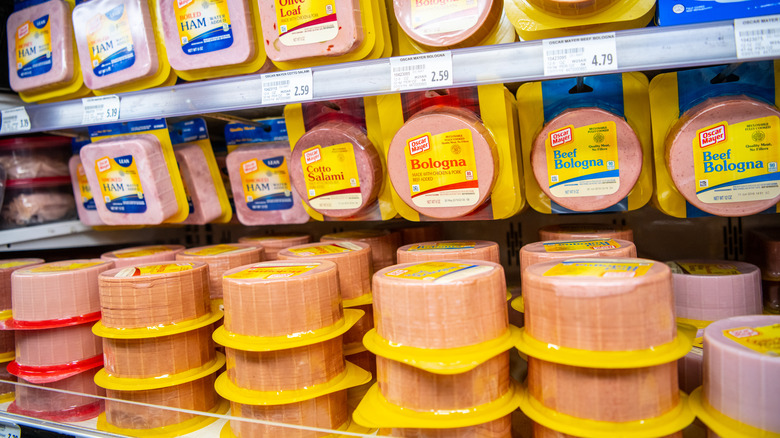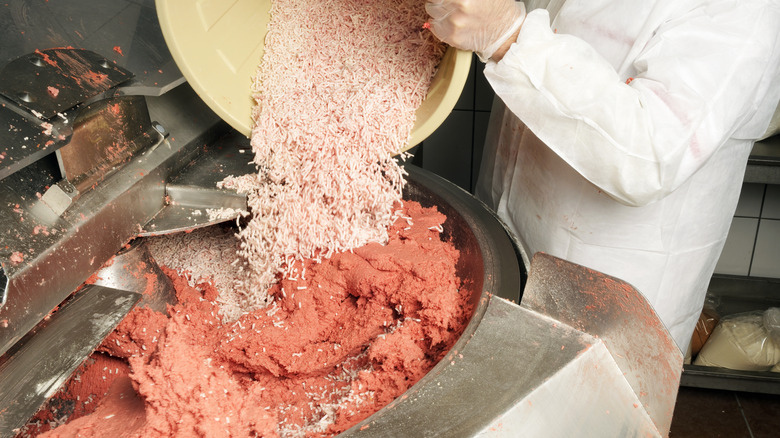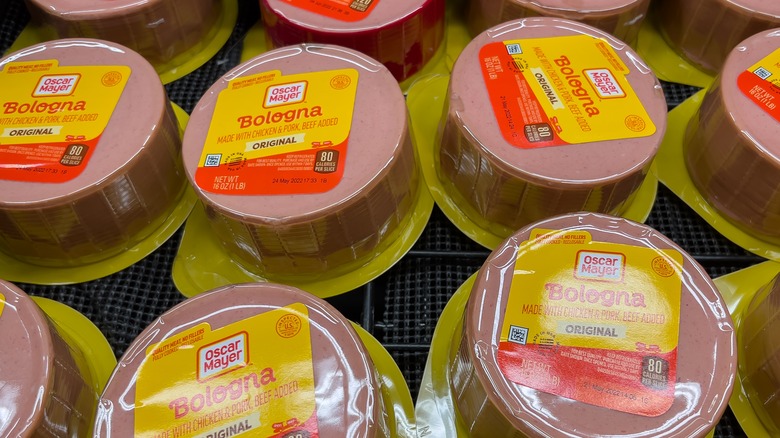False Facts About Bologna You Thought Were True
What comes to mind when you think of bologna? A circle of pink meat with a red band around the exterior, sandwiched between two pieces of white bread with a yellow square of processed cheese? Maybe you grew up in a family that fried their bologna, and you imagine breakfasts with slightly charred pieces of crispy bologna, curled up on the edges and served with eggs. Or, perhaps you have no fond childhood memories that include bologna and so you just imagine the latest headlines regarding the negative health effects of processed meat.
No matter your relationship with bologna, chances are that you have a few misconceptions surrounding this lunchmeat. Its past is more complicated and likely far fancier than you ever imagined, and it's anything but an all-American junk food. It's hardly an American classic at all if you remove the last century or so from the history books. Here's what you need to know regarding the false facts about bologna to set the story straight. More importantly, we'll get to the bottom of the actual truths surrounding the luncheon meat.
False: Bologna has always been cheap, working-class food
It's easy to think that bologna is just a cheap, working-class food because it is indeed fairly inexpensive and often paired with ingredients like white bread and American cheese. Additionally, because it's easy and cheap to process, store, and serve, in the mid-20th century it became a staple in institutions that needed to feed a lot of people cheaply and easily (think schools and prisons). However, just because it's a simple meat that isn't typically served on a slice of focaccia or baguette with Gruyère, that doesn't mean bologna has always been in a subpar category. That transition only came with the rise of the packaged food industry.
Instead, bologna traces its roots right back to the city that shares its name — Bologna, Italy — and its predecessor, mortadella. Locally, mortadella is still a masterpiece and a beloved regional staple, a papacy-protected delicacy that requires skill and artistry to prepare. Clearly, bologna's ancestor gets far more respect than its Oscar Mayer counterpart does on this side of the Atlantic.
False: Bologna and mortadella are the same
While mortadella was the precursor to today's bologna, which shares a name with the Italian culinary hub that claims mortadella as its own, it's important to note that the two meats are not identical. Yes, they are very similar and resemble one another in a variety of ways, from texture to taste to origin, but there are noteworthy differences between bologna and mortadella.
For one, mortadella is made with high-quality pork only. In contrast, bologna can be made using a variety of meat as the base. Additionally, bologna is processed in such a way that produces a singularly textured and singularly hued round slice of meat, identical to every other slice in the stack. Mortadella, on the other hand, is spotted with pockets of fat and other ingredients such as spices and pistachios, which give the light pink slices more variety of texture, color, and flavor. Of course, mortadella is prized as part of Bologna's culture and heritage, whereas bologna doesn't always get a great rap. In other words — if you've tried one and not the other, you may be missing out. Both bologna and mortadella bring their own nuances to the table.
False: Bologna is all-American
While bologna can trace its roots to Italian mortadella, today, it is pretty much exclusively connected with the United States and as associated with our cuisine as hot dogs and apple pie. However, bologna is not an all-American invention. It's not even the case that an American went to Italy, discovered mortadella, brought a recipe back home, tried to replicate it, and then ended up with bologna. Instead, like so many foods now labeled as all-American, bologna came over to the U.S. with immigrants who spread their cuisine far and wide.
While it's not entirely verified, it's believed that German immigrants can be credited with introducing bologna to the United States. The regions where bologna food culture is prevalent are the same areas that have historically been home to pockets of German immigrants. Still, you can't claim that Germans brought bologna to America and then it became an all-American food, because other countries have their own claims on the stuff too. For example, the Newfoundland Times, in Canada, claims that bologna is "synonymous" with the province. In Australia, they also eat bologna, but people just call it polony. The point? Americans don't have an exclusive claim on modern bologna.
False: All bologna is the same
The grocery store lunchmeat aisle typically contains ham, chicken, turkey, and, of course, bologna. You can pretty much reliably find Oscar Mayer products throughout the United States, but just because that's the most prevalent type of bologna, it doesn't mean that's the only option that exists. Even if you're just looking at bologna products in the United States — not mortadella in Italy, nor polony in Australia — there are still regional takes on this meat.
German bologna (yes, supposedly all American bologna comes from German immigrants, but now we have a specific type called German bologna, too) typically has a strong garlic flavor. Lebanon bologna comes from Amish country in Pennsylvania and is made with an array of spices then smoked, for a summer sausage-like consistency. Ring bologna is very much like regular sandwich bologna, but it comes in a large sausage-ring case for bite-sized rather than sandwich-sized slices. Sweet bologna has — you guessed it — a sweetener added, whether that's maple syrup, corn syrup, or plain sugar.
False: Bologna is mystery meat
Maybe it's because it was produced and sold so cheaply throughout the last century, or because it's been typically served in institutions like schools and prisons, or possibly that when you look at a pink slice you can't automatically identify what animal it came from — whatever the case, bologna has developed a reputation as a mystery meat (much like hot dogs). However, just because you can't look at a slice of bologna the way you might a rack of ribs or ham hock and immediately categorize the animal's anatomy, that doesn't mean the U.S. Department of Agriculture (USDA) is just letting producers put any ol' "meat" into your meat. Bologna is not as mysterious as it seems.
According to the USDA, bologna is grouped into the same category as hot dogs. For all food items in this group, the USDA requires that the maker clearly identify what kind of meat is in the item. Additionally, if the bologna contains "meat byproducts," the USDA requires that they be named on the label, too. In other words, this mystery is one you can solve with just a little reading.
False: Bologna can be made from any meat or animal product
Have you heard the story of the factory where they just sweep the floor after the rest of the meat processing is finished and throw whatever they find into a vat and call it bologna? Horror stories surrounding the contents of bologna run rampant, and kids and adults alike joke about all the suspicious and potentially nasty ingredients lurking in processed meat. However, just like the USDA ensures bologna's ingredients aren't a mystery, it also guarantees that producers aren't just slapping a bologna label on anything.
According to the USDA, bologna must be made from beef, pork, turkey, chicken, or a mix of these proteins. Furthermore, the USDA doesn't permit certain types of mechanically separated meat to be used, such as mechanically separated beef (which is not considered safe for human consumption). Likewise, if a manufacturer uses a mechanical separator to remove meat from the bones for bologna and hot dog use, the machinery must meet certain specifications to guarantee that ground or crushed bones do not end up in your food.
False: Bologna is bland
Just because bologna is a little bland looking (it is a lot of pale pink, to be fair) and might not contain the variety of ingredients you'll find in mortadella, that doesn't mean bologna is also bland tasting or boring. In fact, you might find yourself surprised by the spices contained in the average bologna slice. Coriander, nutmeg, garlic, celery seed, allspice, and myrtle berry regularly make the cut.
You likely already know most of these seasonings and may even have several in your spice cabinet at the moment ... but what is myrtle berry and what is its role in making bologna? As it turns out, the ingredient is directly connected to bologna's Italian roots, because the dried berries are a Mediterranean spice. With a flavor likened to citrus and rosemary, myrtle berry has been historically used in wine and desserts and is believed to offer an array of health benefits.
False: Hot dogs and bologna are the same
Yes, they both have more or less a similar consistency. Yes, they're both pale pink and emulsified meat products. Yes, they're sold next to one another at the grocery store and, yes, the USDA lumps them into the same category as far as food safety and inspection guidelines go. That being said, hot dogs and bologna are not exactly the same – and no, it's not just about the obvious size difference. Hot dogs are not just smaller cylinders of bologna and bologna is not just an oversized hot dog processed into slices.
Despite all the similarities in processing and meat content, experts confirm that there are indeed differences in flavors, seasonings, and the end product that create a distinction between hot dogs and bologna. For example, hot dogs are often smoked and may have mustard powder added to the recipe. Hot dogs often come with their casing intact, but bologna does not. Likewise, you're probably not going to find myrtle berry in your hot dog. At the end of the day, you could consider hot dogs and bologna to be siblings — they share a lot of the same DNA, but they're not identical.
False: Spam and bologna are the same
For anyone who's had a taste of both Spam and bologna, the idea that they could be the same product is clearly false. However, it's still a misconception that comes up, particularly among those who deem all processed meats like Spam and bologna to be mystery meats. But just like there are differences between bologna and hot dogs, there are even more differences between Spam and bologna.
The biggest distinction is evident when you look at their ingredient lists. Spam contains six ingredients: pork, salt, water, potato starch, sugar, and sodium nitrite. All of these items are mixed together, loaded into Spam cans, cooked right inside the sealed containers, and then sent on their way. Easy-peasy. In contrast, bologna contains far more ingredients — including many that the average consumer may not be able to confidently identify by name. If you're trying to simplify your diet, you might just find yourself reaching for a can of Spam.
False: It's really spelled baloney
For children who come across the spelling of "bologna" for the first time, they might be a little shocked. To most American ears, the word doesn't quite sound the way it's spelled. Surely "baloney" must be the proper spelling, right? Well, while baloney is a slang term that does indeed exist, it's not a word that came about in conjunction with bologna as the food became increasingly Americanized over the decades. Instead, "baloney" is slang for "nonsense," and it's a term that grew in popularity in the earlier part of the 1900s when a New York politician began using it to describe federal bureaucracy. It's believed that the slang term may have been derived from the Irish word "blarney," which also means "nonsense."
So then why do we pronounce "bologna" as "baloney" and not like the Italian city for which the meat was named? One linguist told HuffPost that this was just an instance of Americans replacing the "ia" in Italian words with a "y" (i.e., Italia becomes Italy). The pronunciation of the city of Bologna sounds as if it has an "ia" at the end, and most likely, Americans Americanized the word, turning it into "baloney."
False: Bologna is completely unhealthy
If you've scanned health-related headlines in the last year or so, you may have gotten the impression that all deli meat — including bologna — is horrible and completely unhealthy. What's more, you may have concluded from the headlines that not only is deli meat bad for you, but it's downright dangerous and causes all sorts of cancers. Whereas headlines like to dramatize the impacts that certain foods can have on our bodies, experts are a little more moderate in their claims.
One expert told The New York Times that although bologna isn't exactly great for you, much like all processed foods, you can eat it in moderation without any significant worry. Similarly, a nutritionist told USA Today that granted, prepackaged deli meat is high in preservatives and sodium, but it can still be a source of protein in small quantities. However, if you already have a health concern like high blood pressure, you may want to be extra cautious about your consumption. When buying any deli meat, Cleveland Clinic recommends choosing meat sliced at the deli counter rather than pre-packaged options which typically contain more preservatives and additives.
False: You can't eat bologna when you're pregnant
For years, the common understanding has been that people shouldn't eat lunch meat while pregnant. If they did, the individuals and their unborn children were thought to be at risk for dangerous and potentially fatal food-borne illnesses. In particular, listeria was a big worry as it could lurk everywhere from unpasteurized milk to chicken salad and yes, lunchmeat. However, this is a broad generalization that overlooks some specifics, so it shouldn't be taken at face value.
For example, the USDA further clarifies that lunchmeat is only a risk if it hasn't been thoroughly reheated. So, while you might not want to eat a piece of bologna right out of the fridge, if you put the slice on a sub sandwich and reheat it to 165 degrees Fahrenheit, you should be safe. One doctor spoke with Healthline and agreed, further noting that heat should reduce the risk of listeria. That said, even with cold lunchmeat, the doctor indicated the risk is still pretty low — and, for some people, worth it and entirely not an issue with pregnancy.
False: You won't find bologna in any self-respecting restaurant
Sure, bologna may be fine for a quick lunch at home, but would you really expect to see it at a restaurant? It's cheap, ultra-processed, and hardly a healthy superfood. However, while it might not be the first thing you expect to see on a menu, bologna still shows up in trendy restaurants around the country as chefs sing its praises.
In New Orleans, sandwich shop Turkey and The Wolf made a name for itself with a fried bologna sandwich, attracting praise from the likes of Guy Fieri and even grabbing a spot as the best new restaurant in the country in 2017. Meanwhile, Momofuku founder David Chang was open about his love for bologna in GQ, calling it a "blank canvas of pureed meat, ready for inspiration to take hold." At some restaurants, chefs are giving bologna an upgrade, pairing it with brioche, aioli, vinaigrettes, and more. Is your mouth watering? Maybe — just maybe — the glowing endorsements of culinary tastemakers are enough to convince you to pick up a pack of bologna during your next grocery run. Perhaps all the lunch meat needs is a bit of rebranding.













